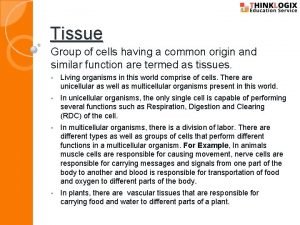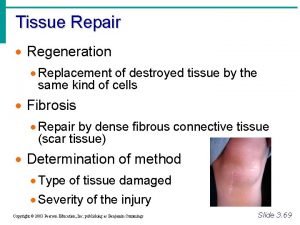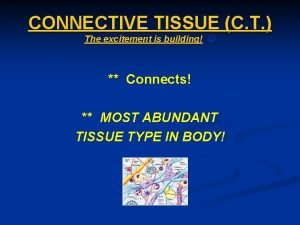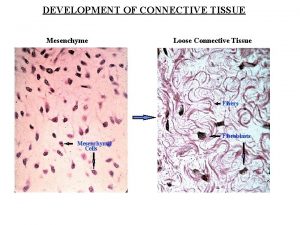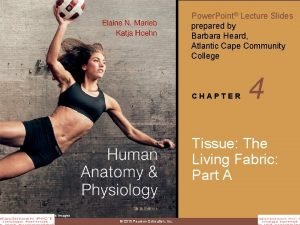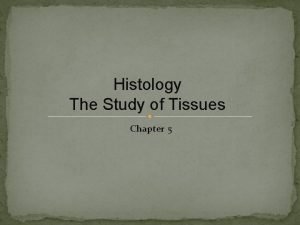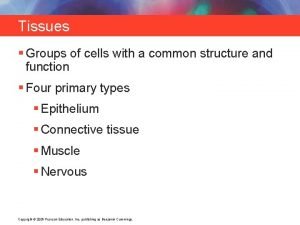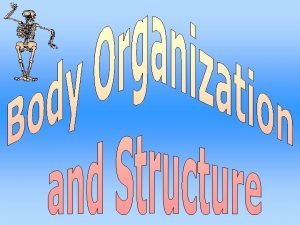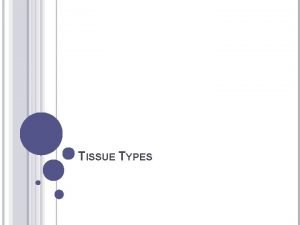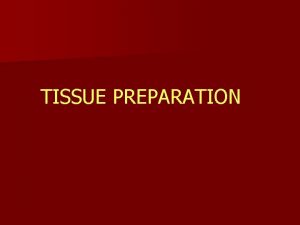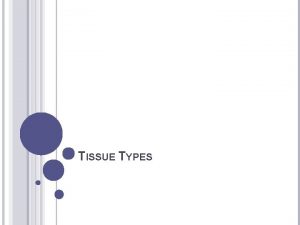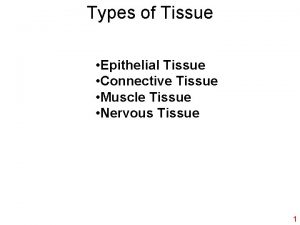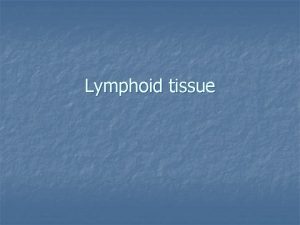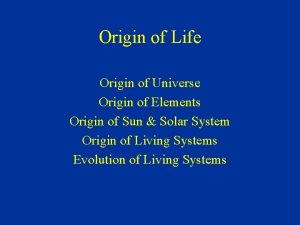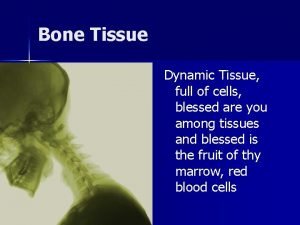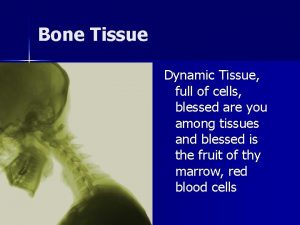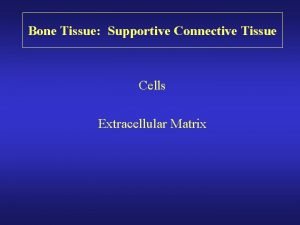Tissue Group of cells having a common origin






























- Slides: 30

Tissue Group of cells having a common origin and similar function are termed as tissues. • Living organisms in this world comprise of cells. There are unicellular as well as multicellular organisms present in this world. • In unicellular organisms, the only single cell is capable of performing several functions such as Respiration, Digestion and Clearing (RDC) of the cell. • In multicellular organisms, there is a division of labor. There are different types as well as groups of cells that perform different functions in a multicellular organism. For Example, In animals muscle cells are responsible for causing movement, nerve cells are responsible for carrying messages and signals from one part of the body to another and blood is responsible for transportation of food and oxygen to different parts of the body. • In plants, there are vascular tissues that are responsible for carrying food and water to different parts of a plant.

The Formation of Tissues • Cells form groups cells that need to perform a single task often group together. • This grouping of cells together to perform a function efficiently is called a Tissue. i. e. , Muscles and Blood. • The tissue cells have the same structure and they perform the same function.

Tissues of Plants and Animals Plant Tissues Animal Tissues ü Plants do not move so their tissues are predominantly the ones that provide support to them so that they can stand straight. ü Animals need more energy as compared to plants because they are not stationary. Their tissues are the ones that can support movement. ü These tissues are made up of dead cells because dead cells can also provide mechanical strength to the plants and do not require much maintenance. ü The tissues in case of animals are made up of living cells so that they can move and perform several functions. ü Only certain parts of the plant can grow. ü Cells in animals grow uniform early and not The tissues present in such regions of and only in certain regions of the body. divide themselves and form new tissues. ü The structure of plant tissues is not very specialized as compared to animals ü The organs and organ systems in animals are highly developed.

Plant Tissue On the basis of the dividing capacity, plant tissues are of two types

Meristematic Tissue • Only certain parts of a plant tend to grow. The tissues located in such parts are called meristematic tissues. • They have the capability to divide themselves and form new tissues. They have thin cell wall made of cellulose. Also have dense nucleus and cytoplasm but lack vacuoles. • They can further we classify differently based on the areas of the plants where they are located - • • • Apical Lateral Intercalary Location of Meristematic Tissue

Meristematic Tissue Apical Meristem Ø They are responsible for the growth of stems and roots in the plants Ø They are found on the tips of the roots and stems. Lateral Meristem Ø They are responsible for Ø increasing the circumference of the middle part of the stem and hence are found there. Ø Causes growth in girth of stem and root. Ø Intercalary Meristem These tissues are present at internodes or stem regions between the places at which leaves attach. These lead to the increase in the length of leaf. E. g. , in grass stem, bamboo stem, etc. Why there are no vacuoles in the intercalary meristem? § Vacuoles are responsible for storage of food in water. The intercalary tissues do not store them. They are rather responsible for manufacturing them. § Moreover, vacuoles contain sap which provides rigidity to a cell. This property of vacuoles may not allow the intercalary tissues to divide and manufacture new cells. Hence vacuoles are not present in them.

Permanent Tissue § A permanent tissue is a group of cells, which is derived from the meristematic tissues, but these cells have lost the power of division temporarily or permanently. § Cells of meristematic tissues change their shape & size to get specialised in performing other functions in plants body. This process is called Differentiation. Types of Permanent Tissues: Simple Permanent Tissues : - Consist of only one type of cells Complex Permanent Tissues : - Made up of more than one type of cells (Conducting tissues. )

Simple Permanent Tissue Two Types of Simple Permanent Tissues: • Protective tissues : These tissue are primarily protective in function • Supportive tissues : These are supportive in function What is Lignin? The cell walls of dead cells have a substance called lignin in them which provides rigidity to the cells. Lignin acts as the cement for the cells.

Protective Tissue Types of Protective Tissues: • • Epidermis Cork/Phellem

Protective Tissue Epidermis Tissues: • The outermost layer of the cell is known as the Epidermis. • It covers the entire plant. • It is a thin layer of single cells but in places with less water, the epidermis of the plants can become thick in order to avoid frequent water loss. • The cells are flat and they have no intercellular spaces between them. • The outer walls of the epidermal cells are thick and the inner walls are thin. • The epidermal cells often have long hair-like structures in roots which facilitate the absorption of water. • The main function of the epidermis is to protect the plants from fungi, water loss and any injuries by secrets a wax (Cutin)-like water-resistant substance called as Cuticle on the surface of the plants which protects the plants.

Protective Tissue Stomata • Stomata are pore-like structures that are present in the epidermis of the leaves. • These pores are enclosed by two cells that have a similar shape as a kidney (pair of bean shaped cells) are called Guard Cells. These are the only epidermal cells which possess chloroplasts, the rest being colourless. . • Guard cells are responsible for the exchange of gases (Photosynthesis respiration) and transpiration.

Protective Tissue Cork or Phellem : • In older roots and stems, tissues at the periphery become cork cells or phellem cells. • Cork is made up to dead cells with thick walls and do not have any intercellular spaces. • The cell walls in cork deposit waxy substance called as suberin. • The cells of cork become impermeable to water and gases due to the deposition of suberin. • The cork cells are without any protoplasm but are filled with resins or tannins. • Cork is protective in function. It prevent desiccation, infection and mechanical injury. • Imperviousness, lightness, toughness, compressibility and elasticity make the cork commercially valuable. It is used for insulation, as shock absorber in linoleum. • Cork is used in the making of a variety of sport goods such as cricket balls,

Supportive Tissue Five Types of Supportive Tissues: • • • Parenchyma Collenchyma Sclerenchyma Chlorenchyma Aerenchyma

Supportive Tissue Parenchyma • These tissues are responsible for photosynthesis, storage of food, gaseous exchange and floating of plants. • They are a group of living cells with cell wall made of cellulose. • The parenchyma cells have large intercellular spaces between them. • There are thin walls that surround each cell. • They are found in leaves and newly formed branches. • Collenchyma • These tissues are responsible for providing flexibility to the plants so that they can bend easily. • They are a group of living cells with cell wall made of cellulose and pectin. • They have a little intercellular space in between them. Sclerenchyma • These tissues are responsible for making plants hard and rigid. • They are made up of dead cells having cell wall made of lignin. • The cells do not have any intercellular spaces. • The cells present in these • The cells have a long tissues are broad and irregularly structure with thick walls. thick at corners. • They are present in leaves and • They are found in stems, stems of a plant. veins of the leaves and coverings of nuts and seeds. Chlorenchyma : - These tissues are similar to that of parenchyma but they also contain chlorophyll in them. Due to the presence of chlorophyll, they are capable of performing the process of photosynthesis in plants. • Aerenchyma : - They are found in aquatic plants. They are also similar in structure to that of the parenchyma but they have large air cavities in them. These cavities allow the aquatic plants to float in water.

Complex Permanent Tissue • • • Made up of more than one type of cells (Conducting tissues. ) It is also known as conducting or vascular tissue. Xylem & phloem together form vascular bundles Two Types of Complex Permanent Tissues: • Xylem • Phloem

Xylem is made up of dead cells having a thick cell lining. It consists of following Cells (elements) • Tracheids : They are elongated angular dead cells (primitive elements) mainly involved in conduction of water and minerals in gymnosperms. • Vessles : Vessels are cylindrical tube like structures placed one above the other end to end which form a continuous channel for efficient conduction of water. Xylem parenchyma : They are small & thick walled parenchymatous cells subjected for storage of starch (food). • • Xylem sclerenchyma : They are non-living fibres with thick walls and narrow cavities provide mechanical support. Except xylem parenchyma all other xylem elements are dead. The annual rings present in the trunk of a tree are xylem rings. , by counting the number of annual rings, we can determine the age of a tree

Phleom They also consist of both parenchymatous and schlerenc- hymatous cells. . It consists of following Cells (elements) • • Sieve tubes : Sieve tubes are slender tube like structures made up of elongated, thin walled cells placed end to end. The end walls of sieve tube cells are perforated by numerous pores, called as sieve plates. Nucleus of sieve cell degenerates at maturity. However, cytoplasm Tissue 45 persists, because of protoplasmic continuation of sieve tube with companion cell through plasmodesmata. Sieve cells possess slime protein or protein which is concerned with growth and repair of sieve cells. Companion cells : Companion cells have dense cytoplasm and prominent nuclei. Sieve cells & companion cells are so called sister cells because they originate from single mother cell. • Phloem fibre : They give mechanical support to sieve tubes. • Phloem parenchyma : They store food and help in radial conduction of food • Leptome : Main part of phloem involved in conduction of food, which is sieve tube. In xylem, only unidirectional movement is possible while in phloem bidirectional movement can occur. In phloem, except phloem sclerenchyma all elements are living.

Features of Xylem & Phleom Feature Xylem Phleom Cells : Living/dead Dead Living Cell walls : Thickness Thick Thin Material Lignin Cellulose Cross walls None Sieve plates Permeability Impermeable Permeable Cytoplasm None Yes Direction of flow Upwards Down and up Special features Fibres Companion cells Function Carries water and salts Carries sugars

ANIMAL TISSUE Animal tissues are classified into four types based on the functions.

Epithelial Tissue • • They are the protective tissues of the human body. They cover many organs and cavities that are present inside the body. It is found in human body - • The lining of the blood vessels, • Kidney tubules • Lung alveoli • The lining of the mouth • Skin Functions : • the epithelial tissues is to act as a barrier and separate different organs and systems from each other. • Blood vessels are absent and non-nervous in nature. • Cells of epithelium are set very close to each other and the tissue rests on a non-cellular basement membrane. • The cells are permeable. This makes it possible for them to exchange materials between different parts of the body and also between the body and the external environment • Consists of single layer of cells.

Type of Epithelium Different types Simple of epithelium Squamous tissues They have Stratified Squamous delicate cell The epithelium Structure Columnar Ciliated Columnar They are the Columnar lining and Squamous cells column-like epithelial tissues possess a are arranged in shape which have Cilia flat thin several layers tissues present on them structure Alveoli and bowman’s Found in capsule- nephron in kidney Skin Small Intestine Cuboidal They are cube- Glandular These are shaped cells which special gland are involved in cells that can absorption and secrete secretion. substances Respiratory Kidney tubules, system , in the thyroid vesicles & movement of ova in the fallopian tube. in glands (salivary glands, sweat glands) Sweat glands in the skin

Connective Tissue The connective tissues include several types of fibrous tissue that vary only in their density and cellularity, as well as the more specialized and recognizable variants—bone, ligaments, tendons, cartilage, and adipose (fat) tissue

Connective Tissue 1. Fluid or vascular tissue : • Blood and lymph : - Blood is a connective tissue, fluid matrix of blood is plasma having wandering or floating cells, called corpuscles, blood helps in the transportation of various materials such as nutritive substances, gases, excretory products, hormones etc. • Plasma : - Form 55% part of blood. Constitution : 90 -91% : water, 7% : protein (Albumin, fibrinogen, globulin), 0. 9% : inorganic salt etc. • Corpuscles : - Forms 45% part of blood. • Red Blood Cell(RBCs) : - They are also called as erthyrocytes, containing red coloured respiratory pigment called haemoglobin that helps in transportation of oxygen. • White Blood Cell(WBCs - Leucocytes : They are also called as ‘Soldiers of the body’) : - They are irregular, amoeboid, phagocyte cells that protect our body by engulfing bacterial & other foreign particles. They are of five types : Monocytes, Lymphocytes, Basophiles, Neutrophiles, Eosinophils. • Blood platelets or thrombocytes : - They are spindle shaped cells which are involved in clotting of blood

Connective Tissue 2. Skeletal Tissue : - It is hard connective tissue that forms supportive framework of the body. • Bones : - Bones form a framework of the body over which the muscles are wrapped together. The bone tissue is strong and inflexible in nature. Therefore, the bone cells are present in a rigid matrix which is formed from calcium phosphate, Ca. CO 3. • Cartilage : - This tissue is elastic, less harder as compared to bones. Elasticity is due to presence of chondrin (protein). Cells are called as chondroblast, which are widely spaced and matrix is reinforced by fibres. It occurs at joint of bones, in the nose, ear, trachea & larynx. It provides flexibility and great tensile strength.

Connective Tissue 3. Connective Tissue : - It is the most abundant type of connective tissue. It is further divided into following types : • Yellow fibrous connective tissue : - They are very elastic due to the presence of a network of yellow fibres in its matrix called as ligament which attaches bone to bone. • White fibrous connective tissue : - They are very little matrix containing abundant white fibres forming layers. Bundles of this tissue are called as tendons, which attaches muscles to the bones. 4. Aerolar Tissue : • It is the most distributed connective tissue in the body. • This tissue fills spaces inside organs and is found between the skin & muscles, around blood vessels, nerves and in the bone marrow. • It helps in repairing other tissues as well.

Connective Tissue 5. Adipose Tissue : • • • These are oval and round cells, filled with fat globules. The cells are called as adipocytes. It is found in subcutaneous layer below the skin, around the heart, brain and below the eyeballs. It acts as an insulator and prevents loss of heat from the body.

Muscular Tissue • • • Movements are brought about in our body with the help of muscular tissues. They are long fibre-like cells called muscle fibres. They are capable of contraction or relaxation. Types of Muscular Tissue

Muscular Tissue Types of Muscular Tissue Striated/ Skeletal/ Voluntary muscles Cardiac Muscles Smooth/ Unstriated/Involuntary muscles These are special kinds of involuntary We can move them according to our own We cannot start or stop the movement muscles. will of involuntary muscles. The muscles of the heart are called Cardiac Muscles, they perform rhythmic contraction and relaxation throughout our life. They are also called Skeletal Muscles as they are attached to the bones. They also called Smooth Muscles. They are cylindrical in shape, they have They are also called Striated branches and there is a single nucleus. Muscles because of the presence of dark Muscles because they do not have and light bands over them They are also called Unstriated any light or dark bands on them. Cardiac muscle consists of individual The cells of voluntary muscles have more heart muscle cells connected by than one nucleus, they do not have any The cells of the involuntary muscles intercalated discs to work as a single branches, and have a long cylindrical are long and have pointed ends. functional organ. structure. For Example, Muscles of the heart. For Example, Muscles of our hands and legs. For Example, The muscles in the alimentary canal and the Iris of our eyes.

Nervous Tissue • Nervous Tissue are capable of transmitting information quickly from the brain to different parts of the body and vice-versa. • Nervous tissues are found in nerves, brain, and spinal cord. • The Nervous tissue is made up of cells called the Nerve Cells or Neurons. • These neurons connect together to form the nerves of our body. Structure of Neurons

Nervous Tissue 1. Dendrites : - They are tree-like extensions (highly-branched) at the Structure of Neurons beginning of a neuron. They increase the surface area of the neuron. They receive chemical signals from different neurons of the body. They convert these chemical signals into electrical signals and pass them to the neuron cell body. A neuron can have a single dendrite or multiple dendrites 2. Cell Body : - Also called Soma. The main function of the cell body and nucleus of the neuron is to maintain the functionality of the cell. It does not play an active role in the transmission of the signal. It produces proteins that are required by different parts of the neuron to work properly. It contains different cell organelles such as mitochondria, Golgi apparatus etc that perform various functions of the cell. 3. Axon : - Neurons have one axon in general. It is a long structure that connects the cell body to the terminals and it also connects with other neurons, cells and organs of the body through nerve terminals. It allows in fast transmission of signals. The larger the diameter of the axon the faster it will transmit signals. It is covered with a special insulating substance called myelin. It helps in rapid transmission of signals.
 Permanent tissue
Permanent tissue Paranasal sinuses development
Paranasal sinuses development Alpha intercalated cell
Alpha intercalated cell Thyroid gland
Thyroid gland Somatic vs gamete
Somatic vs gamete Why dna is more stable than rna
Why dna is more stable than rna Chlorocruorin
Chlorocruorin Is bacteria prokaryotic or eukaryotic
Is bacteria prokaryotic or eukaryotic Animal cell venn diagram
Animal cell venn diagram Prokaryotic cell
Prokaryotic cell Why did robert hooke name cells “cells”?
Why did robert hooke name cells “cells”? Masses of cells form and steal nutrients from healthy cells
Masses of cells form and steal nutrients from healthy cells Younger cells cuboidal older cells flattened
Younger cells cuboidal older cells flattened What cell type
What cell type Which organisms are prokaryotes
Which organisms are prokaryotes Chapter 8 cellular reproduction cells from cells
Chapter 8 cellular reproduction cells from cells Cells cells they're made of organelles meme
Cells cells they're made of organelles meme Adipose connective tissue function
Adipose connective tissue function Connective tissue
Connective tissue Replacement of destroyed tissue by the same kind
Replacement of destroyed tissue by the same kind Cells and fibres of connective tissue
Cells and fibres of connective tissue Dense regular ct
Dense regular ct Ciliated columnar epithelial tissue
Ciliated columnar epithelial tissue Reticuloendothelial tissue is composed of cells that are
Reticuloendothelial tissue is composed of cells that are Tissue origin
Tissue origin How is aerolar tissue different than aerenchyma tissue?
How is aerolar tissue different than aerenchyma tissue? Dances that show imagery combat
Dances that show imagery combat Select from where and
Select from where and Muscle tissue parts
Muscle tissue parts Cells working together form
Cells working together form Cells are the building blocks of all living things
Cells are the building blocks of all living things
